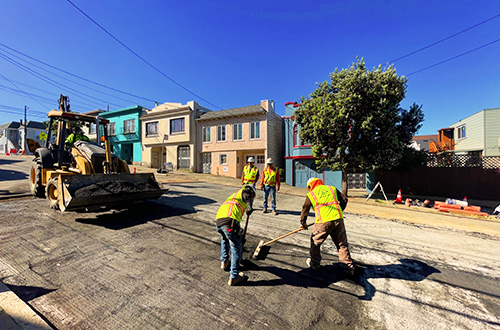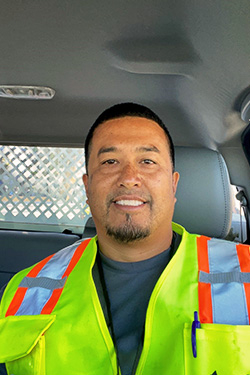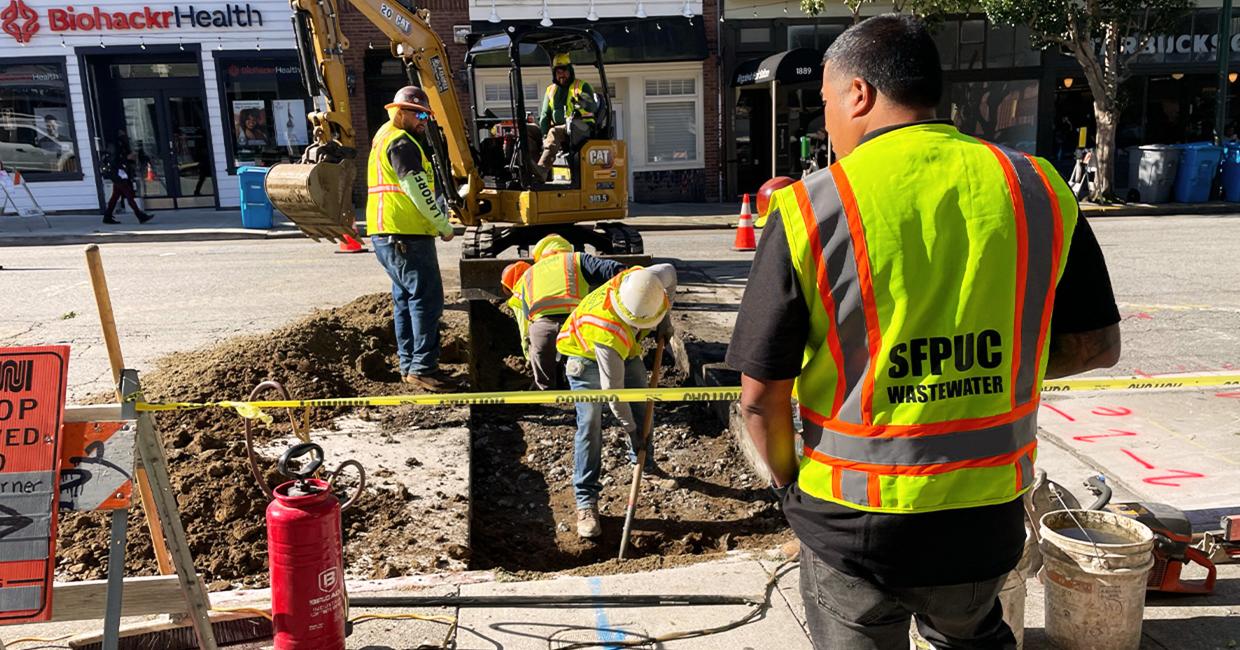Marc Bura drove up to the intersection of 14th and Guerrero Streets on the afternoon of February 7, 2024, hopping out of his truck with more than his usual nimbleness. Staff from the San Francisco Municipal Transportation Agency (SFMTA) and San Francisco Public Works had already cordoned off the area where the roadway collapsed into an underground void. Marc greeted former colleagues from his stints at both agencies. There was a sense of seriousness about the situation, but also the calm confidence of experienced professionals who know how to handle it.
A San Francisco Public Utilites Commission (SFPUC) Sewer Operations crew used a Closed-Circuit Television (CCTV) camera hose to investigate the cause of the void: the 144-year-old brick sewer main underneath 14th Street had failed. More than 30% of San Francisco’s sewer pipes are 100 years old or older; some even date back to the Gold Rush. While SFPUC capital programs upgrade infrastructure, the Spot Sewer Repair program fixes old pipes when they fail without warning, protecting people and the environment and maintaining sewer service.

As Construction Inspector for Spot Sewer Repair, Marc Bura led the repair effort at 14th and Guerrero. A crew from the SFPUC’s construction contractor arrived and got to work, excavating the damaged pipe, bracing it with plywood, and backfilling the hole with sand. They completed emergency repairs that evening and finished permanent repairs inside of a week.
This is the most urgent and complex type of project the team handles, involving a sewer main and a roadway collapse. Most projects involve sewer laterals, the pipe that connects buildings to mains (the SFPUC performs repair or replacement work on the lower lateral, from the curb to the main). The team starts and finishes work on most of their projects within a day. They work on 10 to 25 projects each week.
A Purposeful Career Journey
“My whole life I’ve been surrounded by people who were doing civil service work for San Francisco,” says Marc. His mother worked at the SFPUC in Water Quality, and his father worked his way up to become a superintended at Public Works. His wife works at San Francisco Superior Courthouse.
Marc began his own career with PG&E, first as a mailroom clerk, then as a laborer, fixing gas leaks and installing service lines. “I’m looking around and all I see is dirt,” he recalls. Soon, however, he began to recognize all the different utility lines. “The underground world presented itself to me and it was all very interesting.” He got an apprenticeship as a measurement control mechanic, working with high-pressure gas lines and performing inspections, and eventually he became a journeyman.
In 2007, Marc left PG&E, moving to San Mateo County Hazardous Waste Department, where he worked for seven years. He dealt with emergencies and spills, inspected swimming pools, and collected water samples, meanwhile taking night classes. He was glad to be in the public sector but wanted to work his way back to San Francisco—and back underground. In 2015, he took an opportunity to join SFMTA in the Meter Shop, inspecting meters and overseeing repairs. At the same time, his supervisor encouraged him to expand his network and skills with additional training, like driving school.
Marc became a street inspector for Public Works in 2018 and was thrilled to get back underground. He performed inspections, monitored jobs, activated permits, ensured ADA compliance, and verified materials. His knowledge and connections from SFMTA helped him collaborate between the two agencies. He mentored apprentices, taking them on ride-alongs and taking time to share notes, photos, and videos with them. He instilled mentees with a sense that what they do is important, and taught them to be thorough, ask questions, and build relationships. At this time, he achieved his Six Sigma Yellow Belt certification and took leadership classes.

By 2022, Marc was in high demand. The SFPUC was where he wanted to go, and he accepted an offer from Jerry Rivera, head of the Spot Sewer Repair program, to become Construction Inspector. “In hindsight, I never would have thought that all the places I’ve been play a role in where I am today,” says Marc. As a result of his own experience, Marc treats everyone he comes into contact with as important, reminding them of the critical role they play in projects and encouraging them to pursue their own career aspirations.
Complex, Challenging, Rewarding Work
Marc’s day begins early, sometimes as early as 4 am. Contractors are on the jobsite by 5:30 am and start work at 7.am. The crew breaks up the roadway, digs down to the sewer pipe, carefully avoiding surrounding utilities, repairs or replaces the broken pipe, fills in the hole, and pours concrete and asphalt to restore the roadway. It can all be done by 2 pm if they do not run into unforeseen difficulties. If they do, Marc’s expertise comes into play.
Always on the move, Marc visits every construction site to monitor progress and address issues. Behind the scenes, he coordinates every project: with Public Works to gain the necessary permits, with SFMTA to re-route or de-energize bus lines and put traffic control plans in place. He notifies the SFPUC’s External Affairs team so they can communicate with local government and the public as needed. Marc also communicates directly with constituents, often in person, also receiving and returning phone calls. For the person experiencing a sewer issue, Marc is the one who will see them through to the end of a difficult experience. For the neighbor dealing with parking restrictions and noise, Marc is there to explain why the work needs to be done and deliver the good news of how quickly it will be completed.
One ‘thank you’ letter praised the crew for working “tirelessly from beginning to end.” The property owner said, “This was the best experience and outcome I could have ever hoped for. You turned around a very stressful situation and resolved it so expeditiously with such a positive outcome. We want to express our immense appreciation and gratitude to Mr. Bura, his team members, and the construction crew; we could not have asked to work with a better group of people.”
Another letter says the crew “handled all aspects of the roadwork and sewer pipe replacements with efficiency, expertise, and perfect organization. … There were no delays. NONE! … The neighborhood residents were out watching and applauding the crew’s accomplishments.”
Marc loves the work “because it’s complex and it’s a different job every day. I’m up for a challenge.” He has to think fast and act fast: “My work is surrounded by safety risk. Issues can develop very quickly. I have to understand how to mitigate potential dangers.” Marc says his mind “goes into a mode of a bunch of energy. I turn into this person who has to take charge—people are counting on me.” He takes satisfaction in the execution of a project from scheduling to completion. “Every day is an achievement.”
From his parents to his wife, as well as his brother (who is an engineer for SF Public Works), a family of San Francisco City employees surrounds Marc, and it is only natural to see him thrive as a public servant himself. Outside of work, in addition to spending time with his family, Marc enjoys driving his classic car, and fishing from his boat.


